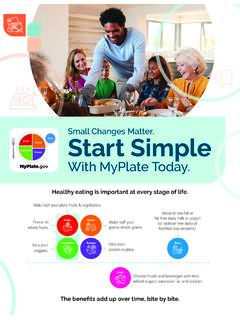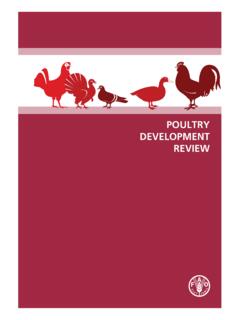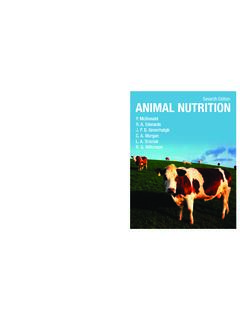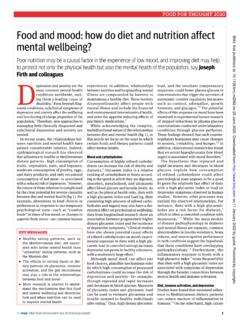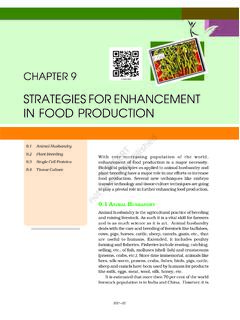Transcription of Dietary Guidelines for Americans, 2020-2025 - Executive ...
1 Page 1 | Dietary Guidelines for Americans, 2020-2025 | Executive SummaryDietaryGuidelinesfor Americans 2020 - Every Bite Count With the Dietary GuidelinesExecutive SummaryThe foods and beverages that people consume have a profound impact on their health. The scientific connection between food and health has been well documented for many decades, with substantial and increasingly robust evidence showing that a healthy lifestyle including following a healthy Dietary pattern can help people achieve and maintain good health and reduce the risk of chronic diseases throughout all stages of the lifespan: infancy and toddlerhood, childhood and adolescence, adulthood, pregnancy and lactation, and older adulthood. The core elements of a healthy Dietary pattern are remarkably consistent across the lifespan and across health the first edition was published in 1980, the Dietary Guidelines for Americans have provided science-based advice on what to eat and drink to promote health, reduce risk of chronic disease, and meet nutrient needs.
2 Publication of the Dietary Guidelines is required under the 1990 National nutrition Monitoring and Related Research Act, which states that at least every 5 years, the Departments of Agriculture (USDA) and of Health and human Services (HHS) must jointly publish a report containing nutritional and Dietary information and Guidelines for the general public. The statute (Public Law 101-445, 7 United States Code 5341 et seq.) requires that the Dietary Guidelines be based on the preponderance of current scientific and medical knowledge. The 2020-2025 edition of the Dietary Guidelines builds from the 2015 edition, with revisions grounded in the Scientific Report of the 2020 Dietary Guidelines Advisory Committee and consideration of Federal agency and public Dietary Guidelines is designed for policymakers and nutrition and health professionals to help all individuals and their families consume a healthy, nutritionally adequate diet. The information in the Dietary Guidelines is used to develop, implement, and evaluate Federal food, nutrition , and health policies Dietary Guidelines for Americans, 2020-2025 | Executive Summary | Page 2 and programs.
3 It also is the basis for Federal nutrition education materials designed for the public and for the nutrition education components of USDA and HHS nutrition programs. State and local governments, schools, the food industry, other businesses, community groups, and media also use Dietary Guidelines information to develop programs, policies, and communication for the general aim of the Dietary Guidelines is to promote health and prevent disease. Because of this public health orientation, the Dietary Guidelines is not intended to contain clinical Guidelines for treating chronic diseases. Chronic diseases result from a complex mix of genetic, biological, behavioral, socioeconomic, and environmental factors, and people with these conditions have unique health care requirements that require careful oversight by a health professional. The body of scientific evidence on diet and health reviewed to inform the Dietary Guidelines is representative of the population it includes people who are healthy, people at risk for diet-related chronic conditions and diseases, such as cardiovascular disease, type 2 diabetes, and obesity, and some people who are living with one or more of these diet-related chronic illnesses.
4 At the same time, it is essential that Federal agencies, medical organizations, and health professionals adapt the Dietary Guidelines to meet the specific needs of their patients as part of an individual, multifaceted treatment plan for the specific chronic and EvolvingAlthough many recommendations have remained relatively consistent over time, the Dietary Guidelines also has built upon previous editions and evolved as scientific knowledge has grown. The Dietary Guidelines for Americans, 2020-2025 reflects this in three important ways:The first is its recognition that diet-related chronic diseases, such as cardiovascular disease, type 2 diabetes, obesity, and some types of cancer, are very prevalent among Americans and pose a major public health problem. Today, more than half of adults have one or more diet-related chronic diseases. As a result, recent editions of the Dietary Guidelines have focused on healthy individuals, as well as those with overweight or obesity and those who are at risk of chronic disease.
5 A fundamental premise of the 2020-2025 Dietary Guidelines is that just about everyone, no matter their health status, can benefit from shifting food and beverage choices to better support healthy Dietary patterns. The second is its focus on Dietary patterns. Researchers and public health experts, including registered dietitians, understand that nutrients and foods are not consumed in isolation. Rather, people consume them in various combinations over time a Dietary pattern and these foods and beverages act synergistically to affect health. The Dietary Guidelines for Americans, 2015-2020 puts this understanding into action by focusing its recommendations on consuming a healthy Dietary pattern. The 2020-2025 Dietary Guidelines carries forward this emphasis on the importance of a healthy Dietary pattern as a whole rather than on individual nutrients, foods, or food groups in isolation. The third is its focus on a lifespan approach. This edition of the Dietary Guidelines highlights the importance of encouraging healthy Dietary patterns at every life stage from infancy through older adulthood.
6 It provides recommendations for healthy Dietary patterns by life stage, identifying needs specific to each life stage and considering healthy Dietary pattern characteristics that should be carried forward into the next stage of life. For the first time since the 1985 edition, the 2020-2025 Dietary Guidelines includes recommendations for healthy Dietary patterns for infants and GuidelinesThe 2020-2025 Dietary Guidelines provides four overarching Guidelines that encourage healthy eating patterns at each stage of life and recognize that individuals will need to make shifts in their food and beverage choices to achieve a healthy pattern. The Guidelines also explicitly emphasize that a healthy Dietary pattern is not a rigid prescription. Rather, the Guidelines are a customizable framework of core elements within which individuals make tailored and affordable choices that meet their personal, cultural, and traditional preferences. Several examples of healthy Dietary patterns that translate and integrate the recommendations in overall healthy ways to eat are provided.
7 The Guidelines are supported by Key Recommendations that provide further guidance on healthy eating across the lifespan. Page 3 | Dietary Guidelines for Americans, 2020-2025 | Executive SummaryThe Guidelines Make every bite count with the Dietary Guidelines for Americans. Here s how:At every life stage infancy, toddlerhood, childhood, adolescence, adulthood, pregnancy, lactation, and older adulthood it is never too early or too late to eat healthfully. For about the first 6 months of life, exclusively feed infants human milk. Continue to feed infants human milk through at least the first year of life, and longer if desired. Feed infants iron-fortified infant formula during the first year of life when human milk is unavailable. Provide infants with supplemental vitamin D beginning soon after birth. At about 6 months, introduce infants to nutrient-dense complementary foods. Introduce infants to potentially allergenic foods along with other complementary foods. Encourage infants and toddlers to consume a variety of foods from all food groups.
8 Include foods rich in iron and zinc, particularly for infants fed human milk. From 12 months through older adulthood, follow a healthy Dietary pattern across the lifespan to meet nutrient needs, help achieve a healthy body weight, and reduce the risk of chronic disease. 12 Follow a healthy Dietary pattern at every life and enjoy nutrient-dense food and beverage choices to reflect personal preferences, cultural traditions, and budgetary healthy Dietary pattern can benefit all individuals regardless of age, race, or ethnicity, or current health status. The Dietary Guidelines provides a framework intended to be customized to individual needs and preferences, as well as the foodways of the diverse cultures in the United States. 3 Focus on meeting food group needs with nutrient-dense foods and beverages, and stay within calorie limits. An underlying premise of the Dietary Guidelines is that nutritional needs should be met primarily from foods and beverages specifically, nutrient-dense foods and beverages.
9 Nutrient-dense foods provide vitamins, minerals, and other health-promoting components and have no or little added sugars, saturated fat, and sodium. A healthy Dietary pattern consists of nutrient-dense forms of foods and beverages across all food groups, in recommended amounts, and within calorie core elements that make up a healthy Dietary pattern include: Vegetables of all types dark green; red and orange; beans, peas, and lentils; starchy; and other vegetables Fruits, especially whole fruit Grains, at least half of which are whole grain Dairy, including fat-free or low-fat milk, yogurt, and cheese, and/or lactose-free versions and fortified soy beverages and yogurt as alternatives Protein foods, including lean meats, poultry, and eggs; seafood; beans, peas, and lentils; and nuts, seeds, and soy products Oils, including vegetable oils and oils in food, such as seafood and nutsDietary Guidelines for Americans, 2020-2025 | Executive Summary | Page 4 4 Limit foods and beverages higher in added sugars, saturated fat, and sodium, and limit alcoholic beverages.
10 At every life stage, meeting food group recommendations even with nutrient-dense choices requires most of a person s daily calorie needs and sodium limits. A healthy Dietary pattern doesn t have much room for extra added sugars, saturated fat, or sodium or for alcoholic beverages. A small amount of added sugars, saturated fat, or sodium can be added to nutrient-dense foods and beverages to help meet food group recommendations, but foods and beverages high in these components should be limited. Limits are: Added sugars Less than 10 percent of calories per day starting at age 2. Avoid foods and beverages with added sugars for those younger than age 2. Saturated fat Less than 10 percent of calories per day starting at age 2. Sodium Less than 2,300 milligrams per day and even less for children younger than age 14. Alcoholic beverages Adults of legal drinking age can choose not to drink, or to drink in moderation by limiting intake to 2 drinks or less in a day for men and 1 drink or less in a day for women, when alcohol is consumed.

